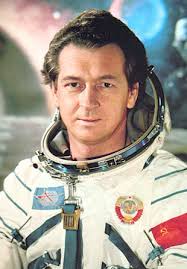Vitaly Sevastyanov
Russian - (RFSA)
Deceased
Date of Birth: July 8, 1935
Date of Death: April 5, 2010
Vitaly Ivanovich Sevastyanov (Russian: Вита́лий Ива́нович Севастья́нов; 8 July 1935 – 5 April 2010) was a Soviet cosmonaut and an engineer who flew on the Soyuz 9 and Soyuz 18 missions.
Soyuz | Soyuz 9
Russian Federal Space Agency (ROSCOSMOS) | RussiaBaikonur Cosmodrome, Republic of Kazakhstan
June 1, 1970, 7 p.m.
Status: Success
Mission:
Soyuz 9 carried cosmonauts Andrian Nikolayev & Vitali Sevastyanov to orbit. The mission lasted 17 days, 16 hours & 58 minutes completing 288 orbits around Earth. They broke the endurance record held by Gemini 7 for 5 years. This was the first crewed space launch that lifted off at night. As of 2016 it still holds the record for longest crewed flight by a solo spacecraft. The goal of the mission was to conduct various pysiological and biomedical experiments on themselves and invastigate possible social implications of extended duration spaceflight.
Low Earth OrbitSoyuz | Soyuz 18
Russian Federal Space Agency (ROSCOSMOS) | RussiaBaikonur Cosmodrome, Republic of Kazakhstan
May 24, 1975, 2:58 p.m.
Status: Success
Mission:
Soyuz 18 was the second and final crew to man the Salyut 4 space station. The mission began on May 24th 1975 at 1458:10 UTC, launching Commander Pyotr Klimuk & Flight Engineer Vitali Sevastyanov into orbit docking with Salyut 4 2 days later. They stayed on the station for 63 days setting a new Soviet space endurance record at the time. Klimuk & Sevastyanov were the back-up crew for the failed Soyuz 18a mission so their mission goals included completing the goals of Soyuz 18a, continuing the work of Soyuz 17 & fixing or replacing equipment. They replaced a gas analyzer, switched a pumping condenser in the water regeneration system with a hand pump & fixed a spectrometer. Mostly the experiments were biological & medical but they also studied stars, planets, earth and its atmosphere with roughly 2000 photographs of Earth and 600 of the sun taken. The mission concluded with a safe landing on June 26th 1975 at 1418:18 UTC.
Low Earth OrbitThe Roscosmos State Corporation for Space Activities, commonly known as Roscosmos, is the governmental body responsible for the space science program of the Russian Federation and general aerospace research. Soyuz has many launch locations the Russian sites are Baikonur, Plesetsk and Vostochny however Ariane also purchases the vehicle and launches it from French Guiana.
Falcon 9
Starlink Group 10-25
Space Launch Complex 40 - Cape Canaveral SFS, FL, USAA batch of 27 satellites for the Starlink mega-constellation - SpaceX's project for space-based Internet communication system.
Falcon 9
MTG-S1
Launch Complex 39A - Kennedy Space Center, FL, USASecond of EUMETSAT's third generation of weather satellite.
New Shepard
NS-33
West Texas Suborbital Launch Site/ Corn Ranch - Corn Ranch, Van Horn, TX, USANS-33 is the 13th crewed flight for the New Shepard program and the 33rd in its history.
Falcon 9
Starlink Group 15-7
Space Launch Complex 4E - Vandenberg SFB, CA, USAA batch of 26 satellites for the Starlink mega-constellation - SpaceX's project for space-based Internet communication system.
H-IIA
GOSAT-GW (Ibuki GW)
Yoshinobu Launch Complex LP-1 - Tanegashima Space Center, JapanGOSAT-GW (Greenhouse Gases Observing Satellite Greenhouse gases and Water cycle), also known as Ibuki GW and formerly known as GOSAT 3, is JAXA's nex…


